HK Audio Lucas Nano 608i Review
HK’s ultra-compact system with iPad mixer could be a PA to suit all kinds of modern gig situations. Marcus Leadley plugs in to the Lucas Nano 608i Details Manufacturer H&K Audio Price £1,499 Contact John Hornby Skews – 01132 865 38 While many readers can be justifiably proud of their mastery of studio-based practice, playing live […]
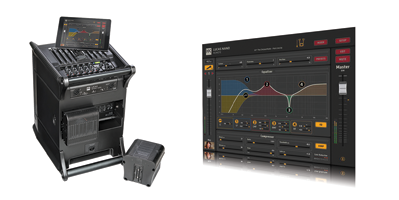
HK’s ultra-compact system with iPad mixer could be a PA to suit all kinds of modern gig situations. Marcus Leadley plugs in to the Lucas Nano 608i
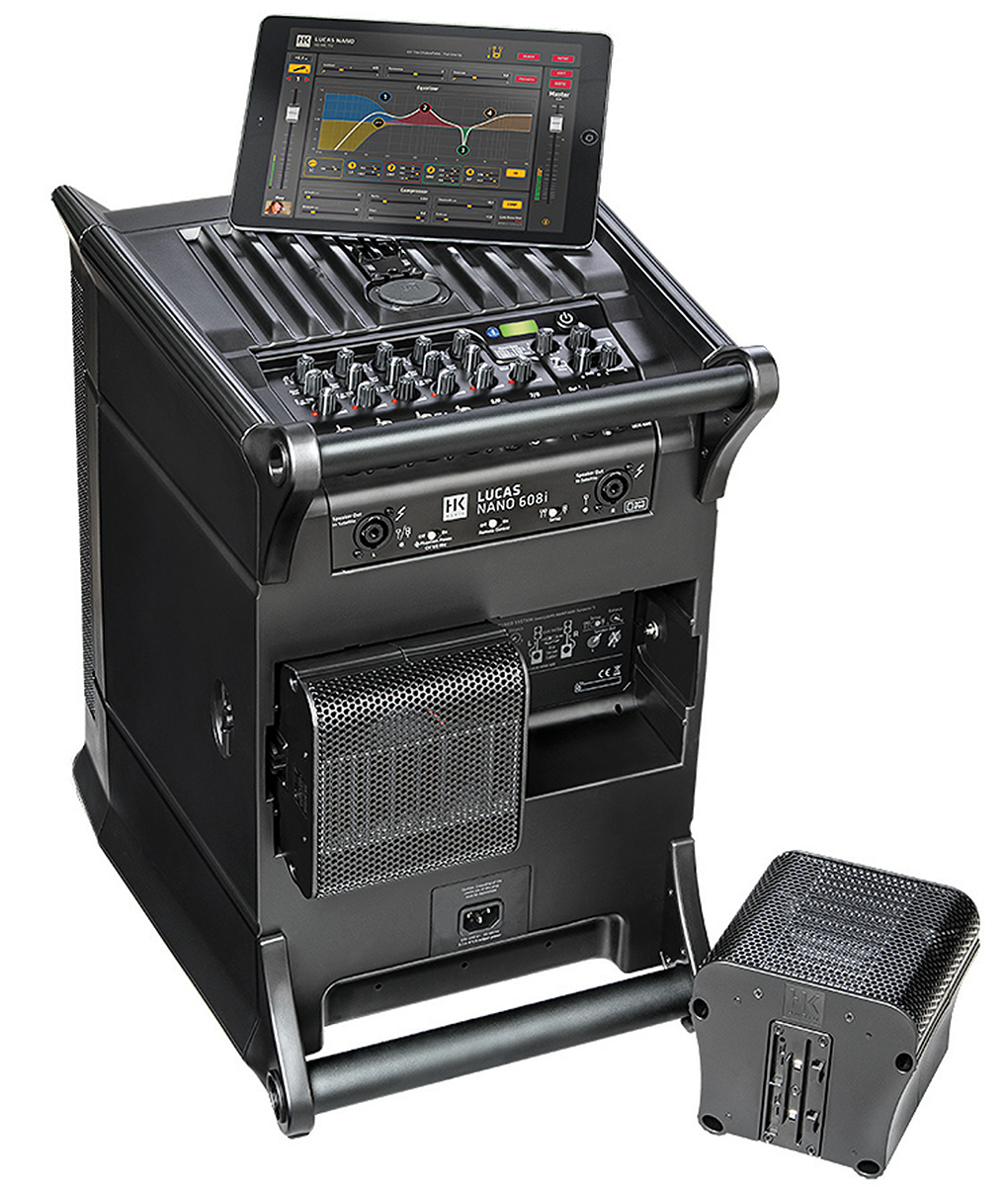

Details
Manufacturer H&K Audio
Price £1,499
Contact John Hornby Skews – 01132 865 38
![]()
While many readers can be justifiably proud of their mastery of studio-based practice, playing live offers a completely different set of challenges, which are often less well understood. This is especially so in an era when gigs come in all shapes and sizes and occur in a diverse range of settings – often in environments that don’t provide any sort of PA. So when we spotted the Lucas Nano 608i at NAMM this year, we got all excited and featured it as one of the six ‘great products of 2016 you might have missed’.
The Lucas Nano 608i is a self-contained portable PA system. Two small satellite speakers stow away neatly in the back of the moulded polypropylene bass subwoofer unit – which also hosts an eight-channel mixer and all the required connectivity.
It can function in mono or stereo and, while all the basic features can be accessed from the physical controls, it’s really designed to be controlled wirelessly by an iPad app that allows you to access many more features. There’s an onboard effects processor and you can even stream music directly via Bluetooth.
While the 608i is certainly portable, it still weighs in at 16.3kgs (35.9lbs) – about the same as a 1×12 guitar combo, so I’d be thinking twice before heading off alone across the fields to the marquee.
Among the many accessories available is a solid-looking bag on wheels for under £100, which might be a good investment. The unit itself feels chunky and reliably solid. There are two grab-bar handles – these also help to protect the recessed mixer controls and the satellite speakers when stowed.
These are securely retained by quick-release twist locks. Each satellite is roughly 14.5cm square and features HK’s patented Multicell Transformer Technology which combines a 4.5-inch woofer with a one-inch HF driver.
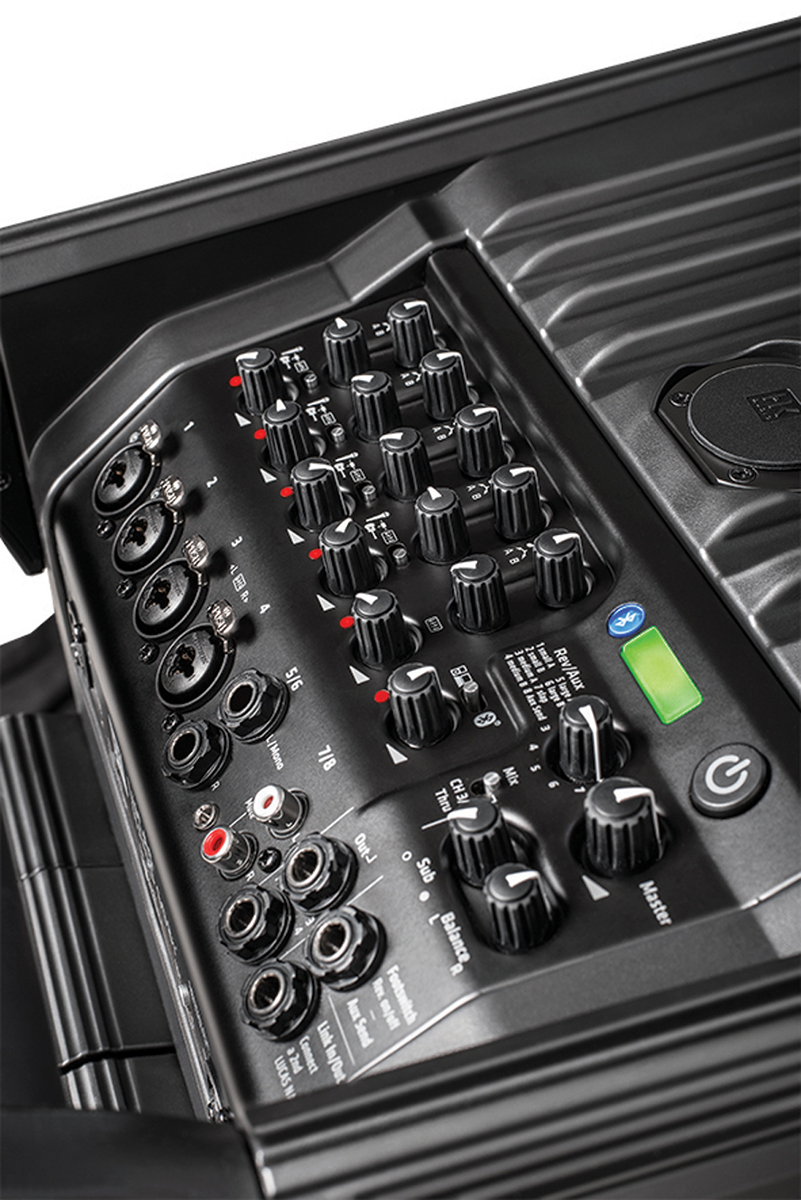
The onboard controls of the Lucas Nano are fine, but the iPad app opens up many more possibilities
If you really want to travel light, both satellites can be clipped together and then clipped directly onto the top of the bass unit to deliver a fully functioning mono column. You can also use an optional S-Connect Pole (£119), which supports the satellites, extends up to 137cm and contains the cable connection. For stereo use of the Lucas Nano 608i, there’s a set of solid HK stereo stands (£129; the kit includes cables and carry bag), or you can use ordinary mic stands, though you’ll need a pair of Speakon cables to connect the units to the back of the bass module.
Lucas Nano 608i – Set Up
In its most basic mono mode, the 608i can be up and running in little more than a minute – literally. Release and mount the satellites, plug in, say, a mic, a keyboard and laptop and turn on.
This works extremely well, but I am a little concerned that the plastic retaining lugs could prove to be a weak point – especially as the mount functions like a camera hot shoe. Any artist using voice and electro-acoustic guitar or keyboard will find this an incredibly simple sound-reinforcement solution.
The mixer gives you four combi jacks for mic/line sources and a pair of TS ¼-inch sockets. Channels 7/8 have a pair of RCA sockets, a mini-jack input and is switchable for a Bluetooth digital audio stream.
So that’s most options covered! Channels 1 to 6 have independent Gain/Volume controls (with Overload LEDs) and contour EQ with a centre-notched rotary control. These channels also have an Aux/Reverb rotary and another rotary offers seven room-size settings and an Aux Send option. This cleverly routes the signal to the dual-function footswitch socket (reverb on/off), so you can connect an external effects processor.
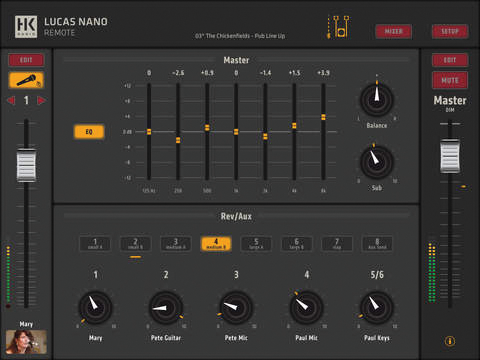
The app’s simplified interface offers easy access to important parameters
It’s suggested you use channel 7/8 as the return. The mixer also has a Master output control and there is independent Level control for the sub and the satellites and a L/R Balance control. There’s a pair of Output jacks, to which you can route the whole mix (to go to a recording device), or just the outputs of channels 3 and 4, which enables a monitor mix to be established.
Finally, there’s a Link socket, so you can expand the system by adding the more basic Nano 600 or a second 608i. As well as more power, you also get more mixer channels this way. On the back of the unit, you’ll find a phantom power switch (essential if you plan to use condenser mics or DIs), a Remote switch to enable iPad connectivity, Speakon connectors and a Mono/Stereo setup switch.
App Attack
Working with the onboard controls is fine, but you will be at a disadvantage if you’re not running the free iPad app. If you don’t own one, HK does make a more conventional Nano 600 with the same power output (at a considerably lower price), but this only offers a three-channel mixer. Once installed, a rock-solid connection is established and it’s pretty much instantaneous when the devices are powered up.
The app is extremely well thought out and easy to engage with. The mixer page offers nice big faders, which respond well to the touch.
Channels 1 and 2 are independent; 3 and 4 can be independent or linked; 5 and 6 and 7 and 8 are stereo pairs and there’s fader control for reverb and master volume. Each channel can be muted and pressing the global edit button gives you access to master EQ and other primary functions. The individual track-edit buttons give you access to a range of features, and there are two modes of operation.
There’s a simple interface with rotary controls for Contour (bass cut/treble boost or bass cut/mid cut), Panorama (L-R panning) and Reverb/Aux, an equaliser (Low, Low-Mid, Hi-Mid, High) and a compressor. However, accessing Expert mode (from the setup menu) loads a new set of modules that give you much deeper control.
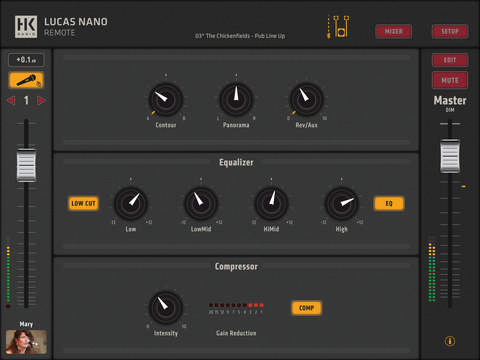
There, a DAW-style EQ with touch-screen manipulation gives you fine control over frequency, gain boost, cut and Q factor. Rather than a single knob for more or less compression, you get Attack, Release, Ratio, Knee, Threshold and Gain controls. There’s also a Scene Memory function, which allows you to save a range of setups – fantastic news if you play a number of venues regularly, or if you work with different input configurations.
Mono or Stereo?
When it comes to PA systems, stereo can be far more problematic than you might at first anticipate. In many situations, it can only work effectively for a small percentage of the audience who are centrally located.
Improved system design in the last 20 years has done much to improve overall diffusion characteristics, but anyone at the periphery of the experience is still likely to hear an unbalanced mix or, if completely out of earshot of one array, a total absence of hard-panned content.
This is why in the live environment, it’s common to use panning very judiciously – principally moving instruments off-axis in order to clear space for a central vocal or lead performance. Phase issues, as a result of sound travelling different distances to the listener’s ears, can be more apparent in stereo situations where sonic relationships between sources are naturally more complex. However, two-channel mono setups are not immune from phase issues, either.
And these problems can be exaggerated when working in the open air. This is one reason why a single-line array (partially emulated by the Nano’s mono, vertical option) still has its uses. Ever experienced weird, washy sound at a carnival? This can be largely overcome by diffusing the sound from a single location.
Lucas Nano 680i – In Use Tip
Unfortunately, the Lucas Nano 608i only lets you use one reverb model at a time, so you might want to reserve its use for vocals, or use it for instruments and feed the vocals in via something like a TC-Helicon VoiceLive – especially if you’re hoping to create a stadium sound in a shoebox venue.
In a small venue, you probably won’t need to mic acoustic drums – however, if you have spare channels then a pair of overheads and a hint of reverb can add a professional sheen to cymbals and snares. And putting a little kick into the PA can also work wonders.
Alternatives
Bose offers musicians a number of different two-channel mono line-array-style personal PAs, starting with the L1 at £799. To get close to the features provided by the 608i, you will need to add a Bose ToneMatch Audio Engine (£391), which adds extra channels (five in total), reverb and EQ. Mackie has the Reach Column System (£749) which has a wireless mixer and an IOS/Android mixer app.
If you’re on a tight budget, then Behringer has the Europort PPA2000BT (£579) with a built-in eight-channel mixer.
Sound
If you’re used to listening to near-field monitors in the studio, this is a very different sonic proposition. The sound is impressively hi-fi and well diffused, rather than accurate – so you wouldn’t want to mix on the system.
However, you could certainly use it in the context of a home-entertainment system when not gigging. In basic mono mode (satellites clipped to the bass unit) and tested with CDs, MP3s and mics, the system delivers plenty of top-end clarity. Despite the summed stereo image, the mids perform creditably and there is little cluttering at low-to-mid volumes.
The bass output is solid, well defined and potentially huge – indeed, it’s too much in many situations. HK makes a good deal of the success of its Anti-Resonance Bracing. However, it’s much better to be dialling the bass back rather than trying to conjure it out of thin air.
There is, however, some inevitable acoustic coupling between the bass unit and satellites in this configuration and the sound becomes confused and messy as we approach higher volume settings. This can be cured by the using the S-Connect pole. Lifting the satellites higher into the air generally improves mono performance immensely. Offering a combined output of 460 watts (300 plus 2x 80 watts), 608i lets you get plenty loud in a small venue – and HK proposes that in mono mode, is ideal for audiences in the range of 80 to 120.
Moving to stereo operation is quite an ear opener. Initial tests with recorded material evidenced an extraordinarily stable image. I tested the system in an untreated room approximately 8x7x3 (high) metres, so not too dissimilar from many small bar/pub/church/art gallery spaces.
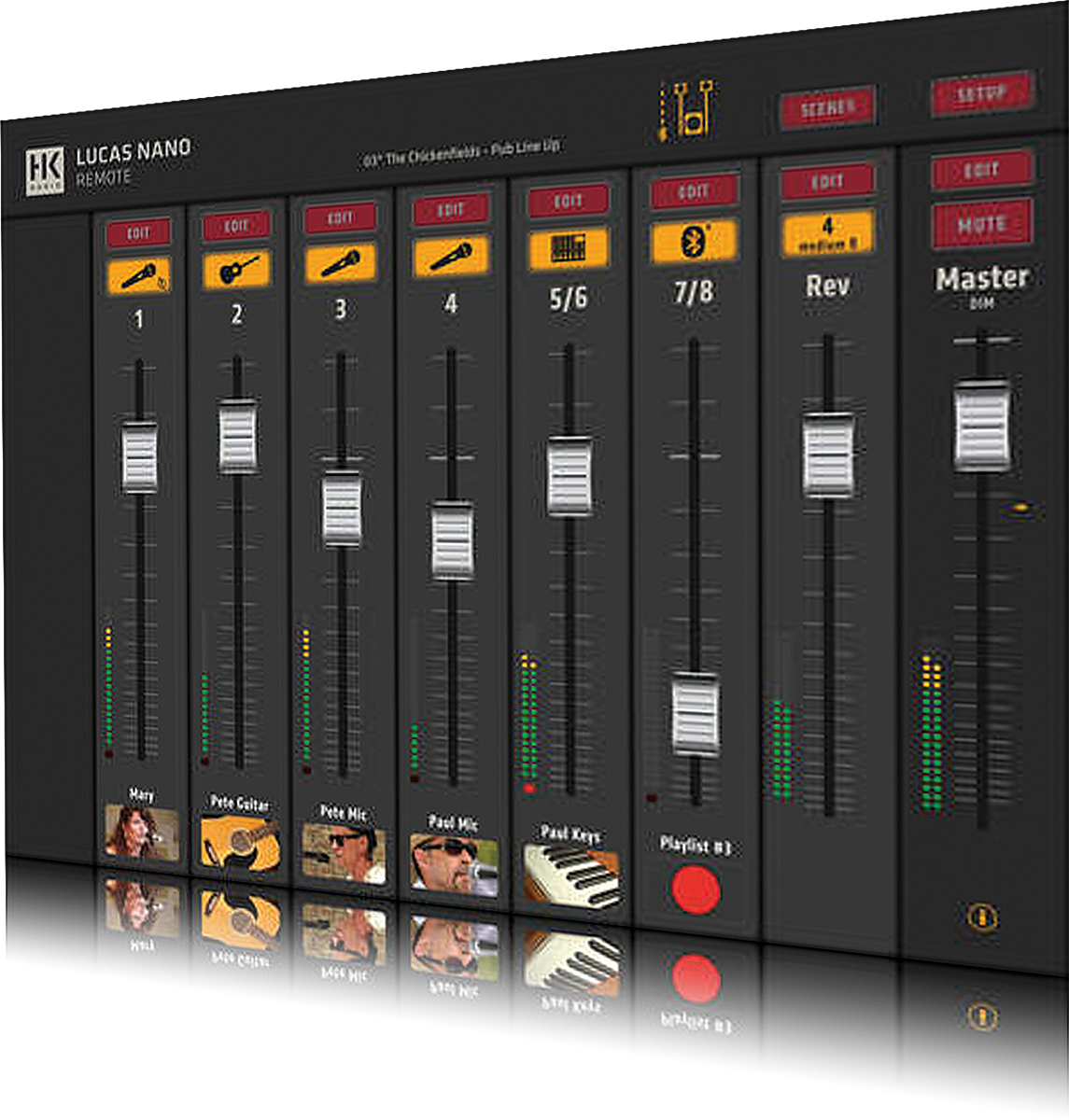
The app’s mixer page provides large and touch-responsive faders for tweaks in the heat of live battle
I found I could move anywhere in a 180-degree arc without experiencing any apparent loss of left or right satellite performance from the Lucas Nano. While there was some top-end roll off when I passed behind the satellites, the sound remained clear and the stereo image seemed to remain essentially (and a little spookily) intact.
This means that a performer/band stationed behind the satellites will still get excellent sound quality to work with. If you’re working with electronic sound sources or recordings, the onboard mixer controls are adequate for many situations. If you’re plugging instruments straight into the 608i, DI boxes will still be an essential part of your kit.
As soon as you start to work with mics and live instruments, the iPad app becomes your best friend. The Expert mode EQ is excellent for notching out feedback and you have the tools to tweak individual channel performance to create a considered and well-balanced overall mix. Being able to mix from anywhere in the room is superb. As an artist mixing him or herself, the iPad can be attached to a stand and the whole system becomes something of an instrument in its own right.
The reverbs sound good, but need to be applied with caution. They can certainly invigorate your sound in a very dead environment. HK suggests the Nano 608i can function effectively for a crowd of up to 200 in stereo mode.
Well, yes, maybe – if you’re working from a raised stage and dealing with a seated and respectful crowd – otherwise, I feel it would struggle. You can run the system flat-out without any issues, it seems, but obviously, you then have nothing extra in reserve
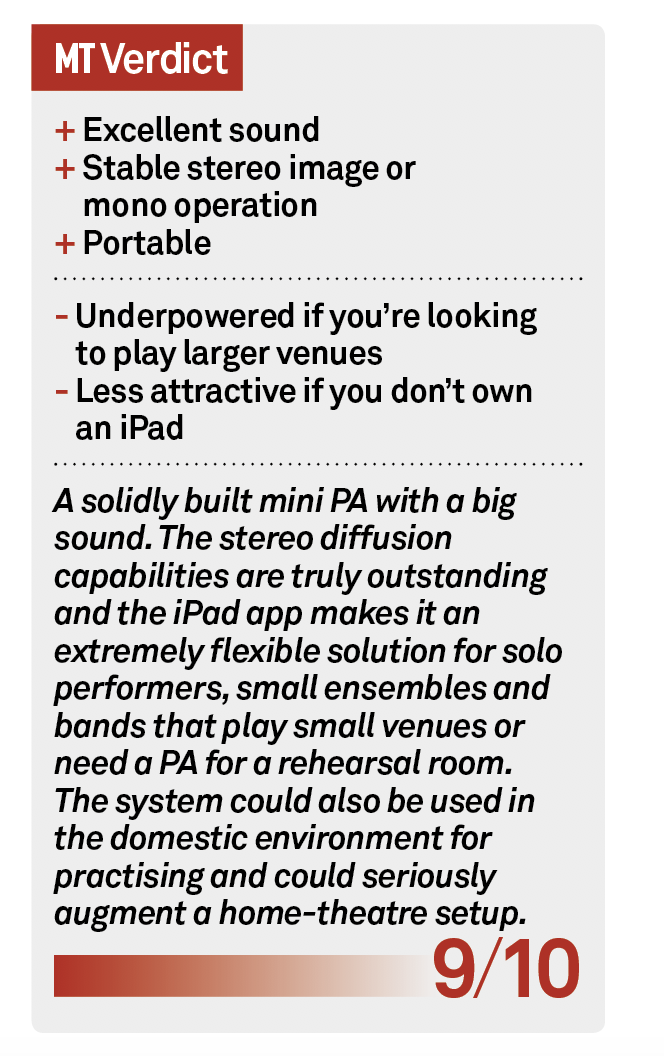
Lucas Nano 608i – Key Features
● Power rating: 460W (300W + 2x 80W) Class D (EIA)
● Frequency response: +/- 3 dB, 43Hz to 20kHz
● 8-channel mixer with built-in DSP preamp and effects section, Bluetooth audio streaming and Bluetooth remote control for additional DSP functions (via NANO REMOTE app)
● Inputs: 4x XLR Combo, 2x 1/4”, RCA/mini jack 3.5mm, Bluetooth audio streaming, Link In for Twin Stereo Mode
● Outputs: Speaker Out, Easy-Click, Rec Out, Footswitch/Aux Send Out, Link Out for Twin Stereo Mode
● NANO REMOTE app for iPad
● Weight: 16.3kg
/ 36lbs


